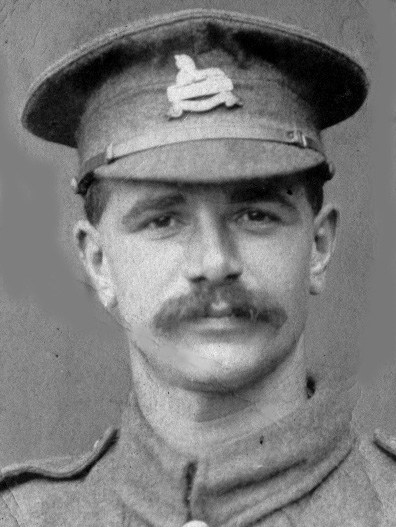William Palmer: Private (203812) Lincolnshire & (260075) 2nd/6th Battalion North Staffordshire Regiments. Killed in Action on the 30th November 1917
William Palmer: Private (203812) Lincolnshire & (260075) 2nd/6th Battalion North Staffordshire Regiments. Killed in Action on the 30th November 1917
The son of Philip and Annie Palmer, William Palmer was born in Balderton, Newark in 1892. William was the eldest boy in a farming family of seven children. By 1906 William was attending school in Bottesford. The Bottesford School Log Book records that in 1906 William was awarded a County Junior Scholarship (Class C) and that he intended to hold the position as a pupil teacher at Sedgebrook School. He did not pursue a teaching career and instead he took up work on the family farm. Military Service No records survive giving full details of William Palmer’s service in the First World War. However, his Medal Index Card indicates that he served with both the Lincolnshire Regiment as a Private (203812) and with the North Staffordshire Regiment (Service Number 260075). He was not listed for the ’14-15 Star’ and therefore would not have seen active service prior to the 31st December 1915. The number of the battalion he served with in the Lincolnshire Regiment is not recorded. The photograph of him wearing a Lincolnshire Regiment cap badge gives details on the reverse of service with the 15th Platoon 2nd/6th Battalion North Staffordshire Regiment. However, his service number with the Lincolnshire Regiment (203812) is in the region of numbers allocated to recruits to either the 2/4th or 2/5th Battalion. The 2nd/5th was formed in Grimsby in February 1915 whereas the 2/4th was formed in Lincoln. Both were were sent to to Ireland with the 59th 2nd North Midland Division in April 1916 where they sustained casualties in fierce fighting during the rebellion against British rule. After withdrawal from Ireland both battalions underwent further training before transfer to France in February 1917 and subsequent front line action. There is also evidence that soldiers from the Lincolnshire Regiment were transferred from Infantry Base Depot (9) in August 1917 directly into the 2/6th North Staffordshire Battalion. This could also have been the case for William Palmer. His new battalion was part of the 59th (2nd North Midland) Division. This division was engaged in pursuing the Germans in their April 1917 strategic withdrawal east from the Somme. May and June was a period of training in advance of the Division’s engagement in the 3rd Battle of Ypres during September 1917. After suffering considerable losses in that battle the Division then relieved the 1st Canadian Division in October in the Lens Sector. They were also given notice that they would be used to capitalise on the expected success of the forthcoming Battle of Cambrai. In mid November they were moved to Bapaume in advance of any engagement at Cambrai. Field Marshal Sir Douglas Haig described the object of the Cambrai operations as the gaining of a ‘local success by a sudden attack at a point where the enemy did not expect it.’ The proposed method of assault was new, with no preliminary artillery bombardment. Instead, tanks would be used to break through the German wire, with the infantry following under the cover of smoke barrages. The attack on Cambrai began early in the morning of 20th November 1917 and initial advances were remarkable. However, by the 22nd November, a halt was called for rest and reorganisation, allowing the Germans to reinforce. From the 23rd to 28th November, the fighting was concentrated almost entirely around Bourlon Wood and by the 29th November, it was clear that the Germans were ready for a major counter attack. During the fierce fighting of the next five days, much of the ground gained in the initial days of the attack was lost. The 2nd/6th Battalion War Diary recorded that the ‘(E)nemy heavily bombarded Bourlon Wood with H.E. (High Explosives).’ 13 The total losses for two days of action were: Officers 1 killed; 3 wounded; 14 gassed. Other Ranks 13 killed; Wounded and gassed 392 of which 64 subsequently died and 15 missing. After the battle the battalion required 455 men to bring it back up to strength. William Palmer was one of those reported missing for the 30th November. Unlike all the other men lost from Bottesford and Muston no details of William Palmer’s death were ever reported in the Grantham Journal. His mother held on to her belief that he might return. His younger brother, Len Palmer, took on the responsibility of running the family farm. William’s name finally appeared on 4th June 1921 in the Grantham Journal listing of those named on the recently unveiled Bottesford War Memorial in St Mary’s Church. He is also remembered on the Cambrai Memorial in the Louverval Military Cemetery. The Cambrai Memorial commemorates more than 7,000 servicemen of the United Kingdom and South Africa who died in the Battle of Cambrai in November and December 1917 and whose graves are not known.
Created by: , David556
-

Died 1917
British Army 203812 Private Lincolnshire Regiment
British Army 260075 Private North Staffordshire Regiment
More about William Palmer
